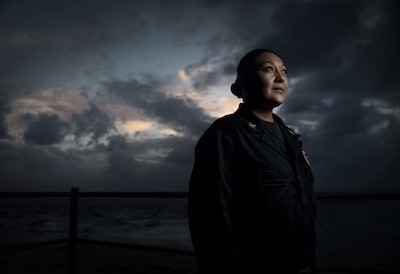By Navy Petty Officer 2nd Class Elesia K. Patten, Carrier
Strike Group 11
AT SEA ABOARD USS NIMITZ, Nov. 27, 2017 — When Navy Petty
Officer 1st Class Denise Alamo introduces herself to other people from the Dine
or Navajo tribes in their native language, the introduction translates to:
"Hello, my name is Denise. I'm Towering House Clan, born for Tangle Clan,
my maternal clan is Salt People, and my paternal clan is Coyote Cross
Path."
"In Dine culture, you must know what your four clans
are because they make who you are," Alamo said. "For instance, when I
introduce myself to another Dine, I would say my clans in the following order:
my mother's clan, my father's clan, my maternal grandfather's clan, and
paternal grandfather's clan.
A proud Navajo woman, Alamo also is a proud U.S. Navy
sailor, assigned to Destroyer Squadron 9 of Carrier Strike Group 11 as an
operations specialist. She's serving aboard the aircraft carrier USS Nimitz on
a six-month deployment to the Western Pacific. Since 1994, the Navy has
reserved November to celebrate and honor Native Americans and Alaska Natives.
Throughout her 18-year career, Alamo said, she has crossed
paths with several other sailors who belong to her tribe. Military service is
fast becoming a tradition in her family; her brother is serving in the Marine
Corps and her grandfather was a Navy Seabee. Alamo said his service motivated
her to join the Navy.
"[My grandfather] always talked about traveling and
seeing different parts of the world," she explained. "I also wanted
to travel. Being a Native American sailor holds much integrity and pride back
on the reservation."
Early Life
Alamo grew up on the Dine Nation Reservation, an area near
Sweetwater, Arizona. Her family owned two houses; one was near the main road in
Sweetwater, and the other was more remotely snuggled in the Carrizo Mountains.
During the school year, she said, they lived in the house on the main road.
Come summer, the family moved to the isolation of the mountain house, where
they herded livestock and raised crops.
"Our nearest neighbor was about a mile away,"
Alamo said. "That house had no electricity or running water. We had a farm
that we maintained during harvest season, and we planted fruits and vegetables
such as corn, apricots, grapes, strawberries, watermelon, cabbage, tomatoes and
avocados."
Alamo's Navy life and her life on the reservation share some
similarities. While deployed, she trades her life on land for a life in a more
secluded environment. Just as up in the mountains, the ocean distances her from
grocery stores, movie theaters and other home comforts. The many customs and
traditions that are so heavily ingrained in the Navy also mirror Alamo's way of
life on the reservation.
Her grandparents enjoyed attending ceremonies and
traditional dances, so during her childhood Alamo attended many dances, she
said. And just as her grandparents ensured the traditions of her people were
passed on to her, she added, she proudly passes on Dine tradition to her
children.
Proud of Her Heritage
"I'm proud to be Dine, and that I know my language,
culture and tradition," Alamo said. "Dine people are also called the
'Holy People'. We have many taboos that we are told to abide by. However, that
tradition is dying with the younger generation. I tend to pass on the taboos of
our tribe on to my kids along with the folk tales and many stories of Coyote
the Trickster. I will also make sure that they know their clans."
Alamo said she draws inspiration and strength from her
people, and that she employs them to inspire her throughout her Navy career. A
saying in her tribe translates to "In beauty I walk," she added.
"To me this means, 'No matter what obstacles are thrown
at you, always strive to better yourself professionally and personally,’"
she said.

No comments:
Post a Comment